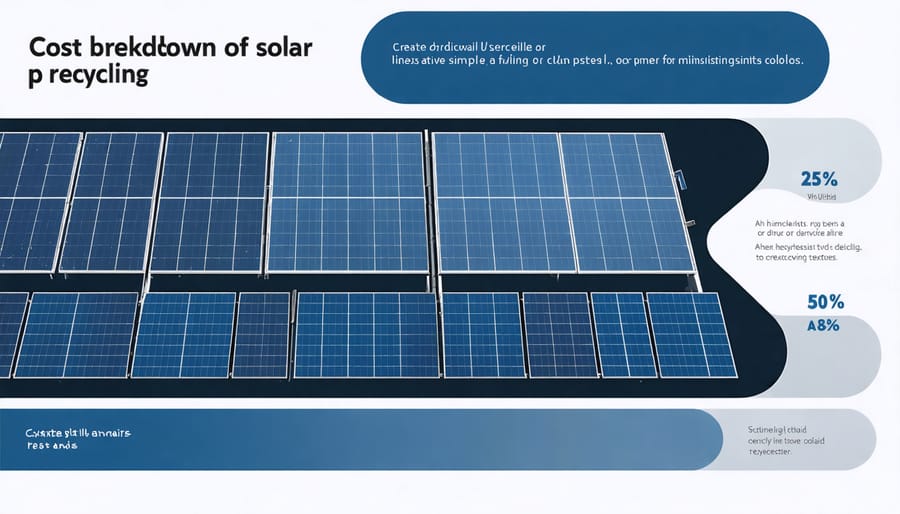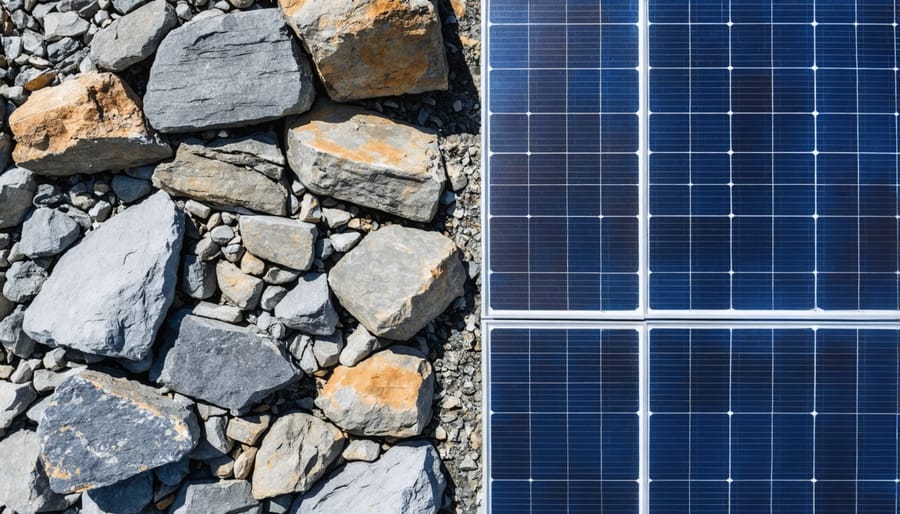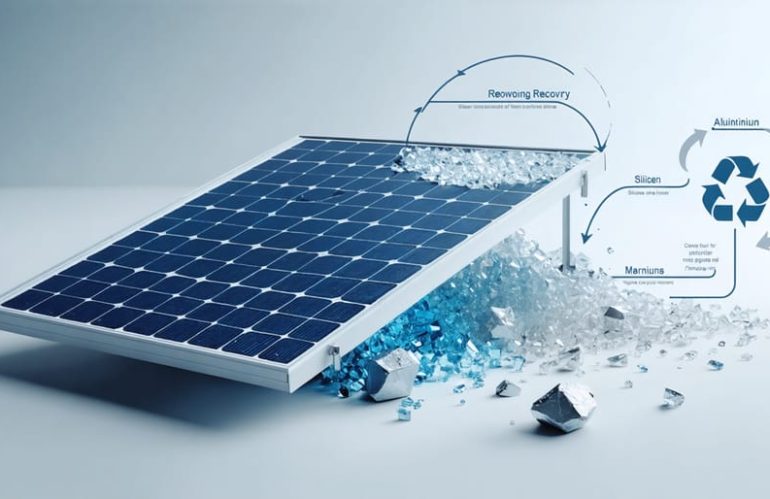Recycling solar panels typically costs between $15-45 per panel for standard residential units, though prices vary significantly based on location and panel type. As solar installations surge nationwide, understanding these disposal and recycling challenges becomes crucial for homeowners planning their long-term solar investment. While specialized recycling facilities can recover up to 95% of panel materials, including valuable silver and silicon, the current infrastructure limitations often impact costs. Several factors influence the final recycling expense: panel condition, transportation distance to recycling facilities, and whether the panels qualify for manufacturer take-back programs. Forward-thinking homeowners can minimize these costs by researching local recycling options early, participating in manufacturer recycling programs, or coordinating bulk recycling with neighboring solar owners. With solar panel lifespans averaging 25-30 years, planning for end-of-life recycling represents a small but important component of solar ownership costs.

Breaking Down Solar Panel Recycling Costs
Transportation and Collection Fees
Transportation and collection fees typically range from $100 to $400 per pickup, depending on your location and the number of panels being collected. Most recycling companies offer scheduled pickup services directly from your home or business, with some providing bulk collection discounts for multiple panels.
Rural locations may incur additional transportation costs, sometimes adding $50-$100 to the base fee. However, many homeowners can reduce these costs by coordinating with neighbors for group collections or taking advantage of seasonal community recycling events that often include solar panel collection.
Some solar installation companies include future recycling transportation in their initial service package, which can save you money in the long run. It’s worth checking if your original installer offers this service before arranging independent transportation.
To minimize costs, consider:
– Scheduling pickup during regular collection routes
– Bundling with other home recycling services
– Looking for local recycling facilities that offer their own pickup services
– Participating in manufacturer take-back programs that may include transportation
Remember to get quotes from multiple service providers, as prices can vary significantly between companies.
Processing and Material Recovery Costs
The solar panel recycling process involves several steps that contribute to the overall cost. The primary expenses come from dismantling and separating materials, which typically ranges from $12 to $25 per panel. Material recovery costs vary depending on the panel type, with crystalline silicon panels being less expensive to process than thin-film panels.
The good news is that recovered materials like aluminum, silver, and copper can offset some recycling costs. On average, recyclers can recover $15 to $20 worth of materials from each panel. Some recycling facilities have started using automated processes to reduce labor costs and increase efficiency, potentially lowering future recycling expenses.
Transportation to recycling facilities represents another significant cost factor, usually ranging from $1 to $4 per panel when done in bulk. Many recycling companies offer pickup services, though costs can be reduced by coordinating with other homeowners in your area for bulk collection.
To minimize expenses, consider working with certified recyclers who have optimized their processes and can provide transparent pricing. Some manufacturers also offer take-back programs that can reduce or eliminate recycling costs for their specific panels.

Cost-Saving Options for Homeowners
Manufacturer Take-Back Programs
Many solar panel manufacturers offer take-back programs that can significantly reduce or eliminate recycling costs for homeowners. Companies like First Solar, SunPower, and Jinko Solar have established recycling initiatives as part of their environmental commitment. These programs typically include free collection, transportation, and processing of end-of-life panels for their customers.
To participate, you’ll need to contact your panel manufacturer directly and provide proof of purchase or panel serial numbers. Some companies extend this service even to panels that are no longer under warranty. The programs often include convenient pickup services, making the process hassle-free for homeowners.
While not all manufacturers offer these programs, the number of companies providing this service is growing. It’s worth checking with your manufacturer before exploring other recycling options, as these programs can save you hundreds of dollars in recycling fees. When purchasing new solar panels, consider choosing a manufacturer with an established take-back program – it’s a smart way to plan for future disposal needs while being environmentally responsible.
Local Recycling Initiatives
Many communities now offer local recycling programs that can significantly reduce the cost of solar panel recycling. Check with your city’s waste management department, as some municipalities have dedicated e-waste collection events where you can drop off solar panels for free or at a minimal cost. Some local utilities and solar installers also participate in take-back programs, offering discounted or complimentary recycling services to their customers.
Community solar cooperatives often maintain relationships with recycling facilities and can help coordinate bulk recycling efforts, which typically lower per-panel costs. Additionally, some areas have solar-specific collection points where multiple panels can be gathered before transport to recycling facilities, reducing individual transportation expenses.
Consider reaching out to nearby solar installation companies, as they may offer recycling services at reduced rates for local residents. Some even include end-of-life recycling in their initial installation packages. Local environmental organizations and sustainability groups can also provide valuable information about available programs and potential cost-sharing initiatives in your area.
Future Cost Trends
The future of solar panel recycling costs looks increasingly promising. As the industry matures and recycling technologies advance, experts predict a significant decrease in processing costs over the next decade. This downward trend is driven by several key factors that are reshaping the recycling landscape.
Automation and improved recycling processes are leading the way in cost reduction. New technologies are making it possible to recover more valuable materials like silver and high-grade silicon more efficiently, offsetting the overall recycling expenses. Industry analysts expect recycling costs to drop by 30-50% by 2030 as these processes become more streamlined.
The growing volume of panels reaching end-of-life is also playing a crucial role. As more panels enter the recycling stream, recycling facilities can achieve better economies of scale, bringing down per-panel processing costs. This increased volume is encouraging more companies to enter the recycling market, fostering healthy competition that further drives down prices.
Policy changes and extended producer responsibility programs are expected to distribute recycling costs more evenly across the supply chain. Many manufacturers are now incorporating recycling costs into their initial pricing, making end-of-life disposal more affordable for consumers.
Innovation in panel design is another promising development. Newer solar panels are being created with recycling in mind, featuring easily separable components and more recoverable materials. This “design for recycling” approach is expected to reduce future recycling costs while increasing the value of recovered materials.
For homeowners planning ahead, these trends suggest that recycling costs will become more manageable in the coming years, making sustainable disposal increasingly accessible and affordable.

Planning Ahead: Smart Recycling Strategies
Planning for solar panel recycling doesn’t have to be complicated or expensive when you take a proactive approach. Understanding the solar panel life cycle helps you make informed decisions about future recycling needs.
Start by keeping detailed records of your installation, including the manufacturer, model numbers, and warranty information. Many manufacturers now offer take-back programs, which can significantly reduce future recycling costs. Consider setting aside a small portion of your energy savings each year – around $10-15 monthly – in a dedicated fund for eventual recycling expenses.
Research local recycling facilities and certified solar waste processors in your area now, even if you won’t need their services for years. This knowledge helps you budget accurately and avoid rushed decisions later. Some localities offer periodic recycling events or group collection programs, which can reduce individual costs through economies of scale.
Consider joining local solar communities or homeowner groups that might organize collective recycling initiatives. These groups often negotiate better rates for bulk recycling and share valuable information about cost-effective disposal options.
Remember to factor in potential transportation costs and investigate whether your installer or local solar companies offer pickup services. Some may even provide discounts on recycling when you upgrade to newer panels, making it worth asking about these programs during your initial installation.
Recycling solar panels is a crucial responsibility that comes with solar energy adoption, and understanding the associated costs helps you plan effectively. While recycling fees typically range from $15 to $45 per panel, these costs can vary based on your location, panel condition, and chosen recycling method. Planning ahead by researching local recycling facilities, participating in manufacturer take-back programs, and considering certified recyclers can help minimize expenses while ensuring environmentally responsible disposal.
Remember that proper solar panel recycling not only prevents hazardous materials from entering landfills but also recovers valuable materials like silver, silicon, and aluminum for reuse. Many regions now offer incentives or subsidized recycling programs, making environmentally conscious disposal more affordable than ever.
As solar technology continues to advance and recycling processes become more efficient, we can expect recycling costs to decrease further. By planning for end-of-life disposal when installing new panels and setting aside a small fund for future recycling needs, you can ensure both environmental sustainability and financial preparedness. Take the first step today by contacting local recycling facilities or your panel manufacturer to discuss your options.









